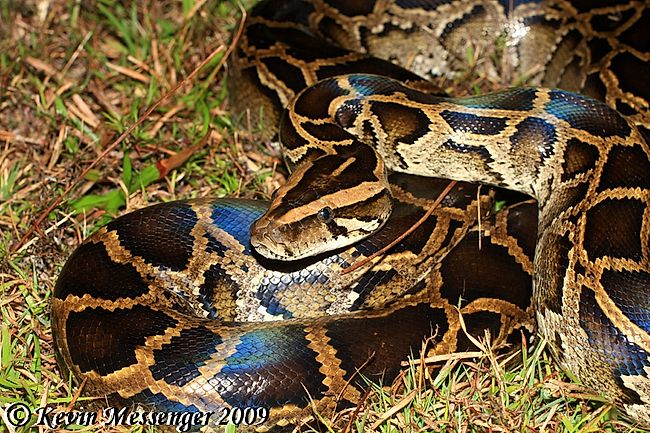Python molurus bivittatus
Burmese Python
緬甸蟒 (mian3dian4mang3)
Status: Not Protected
Non-venomous
More Photos
Family
Colubridae, subfamily Pythoninae
Max. length
360 cm
Occurrence in Taiwan
Only on the Kinmen archipelago (金門)
Global Distribution
The Burmese python is a subspecies of Python molurus, which is found throughout
southeast Asia, from Pakistan to Indonesia (though absent from the Philippines).
The subspecies bivittatus has the largest range of the three subspecies -
including southern China, Indochina, Burma, and portions of Indonesia
(Borneo, Java, Sumatra, and the Celeb Islands).
Description
This is one of the largest of all snakes, growing up to eight meters
(but usually seven) and weighing up to 190 pounds. Its coloration is a
light yellowish cream with a series of brown elongated rectangular
blotches edged with black. There is a lance-shaped mark on the head and neck.
There are a number of facial pits, which are sensitive to changes in temperature
and allow the python to locate warm-blooded prey hiding in concealed areas.
Biology & Ecology
The nocturnal Burmese python lives in lowland forests and swamps, where it feeds on
mammals and birds. The snake uses its sharp backward pointing teeth to
seize its prey, then wraps its powerful body two or more times around the
prey while at the same time contracting its muscles, killing the prey by
asphyxiation.
Pythons move by undulating the ribs backwards and forwards by muscular action while the
ventral scales grip the substrate. They climb well and can suspend
themselves by their prehensile tail. They are also quite at home in the
water, being a good swimmer, and are able to stay submerged for up to half
an hour. In the northern parts of its global range they may hibernate for
some months during the cold season in a hollow tree, a hole in the
riverbank or under rocks.
Sexual maturity is reached in 2-3 years. Pythons are oviparous, and after breeding in
early spring, an average of 12-36 eggs are laid, which the female coils
around to incubate. The incubation period is two months or more. The rate
of growth is influenced by the conditions under which the snake lives.
Pythons have been known to live up to 25 years.
Etymology
Python : From Ancient Greek Πύθων (Puthōn), the name of the mythological
enormous serpent at Delphi slain by Apollo; from Πυθώ (Pūthō), the early
name of Delphi, from πυθώ (puthō), “‘to rot, to decay’”). (Source)
molurus : after the Greek molouros = some kind of snake, the identity of
which is now uncertain (fide WALL 1921). (Reptile Database)
bivittatus: from the Latin prefix bi = two or dual, and vitta = band or stripe
The Chinese name 緬甸蟒 (mian3dian4mang3) means "Burmese (緬甸) python (蟒)"
Further Info






























